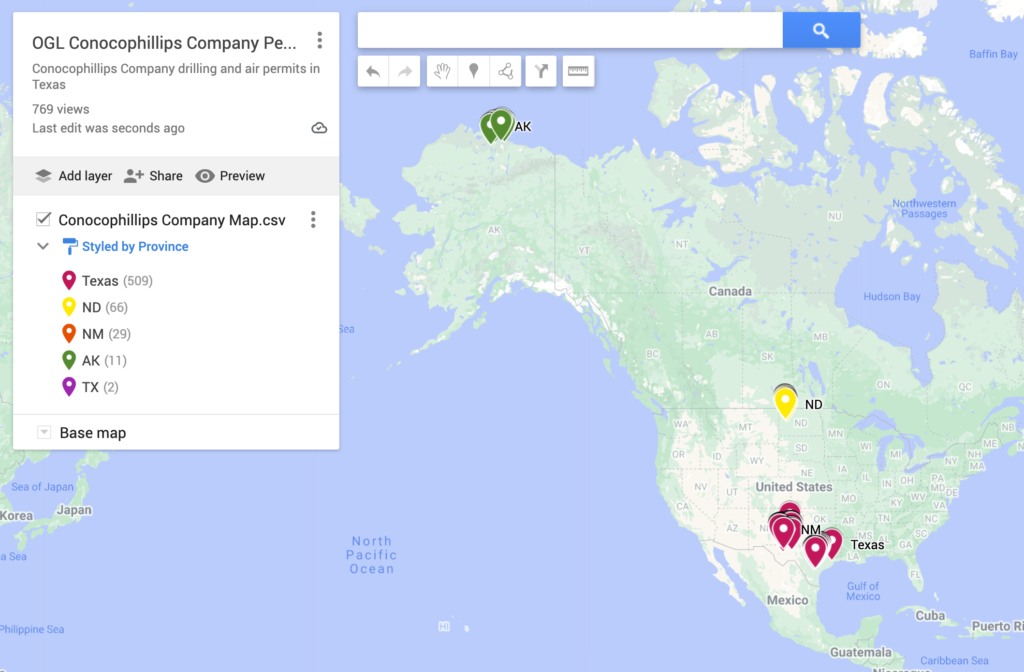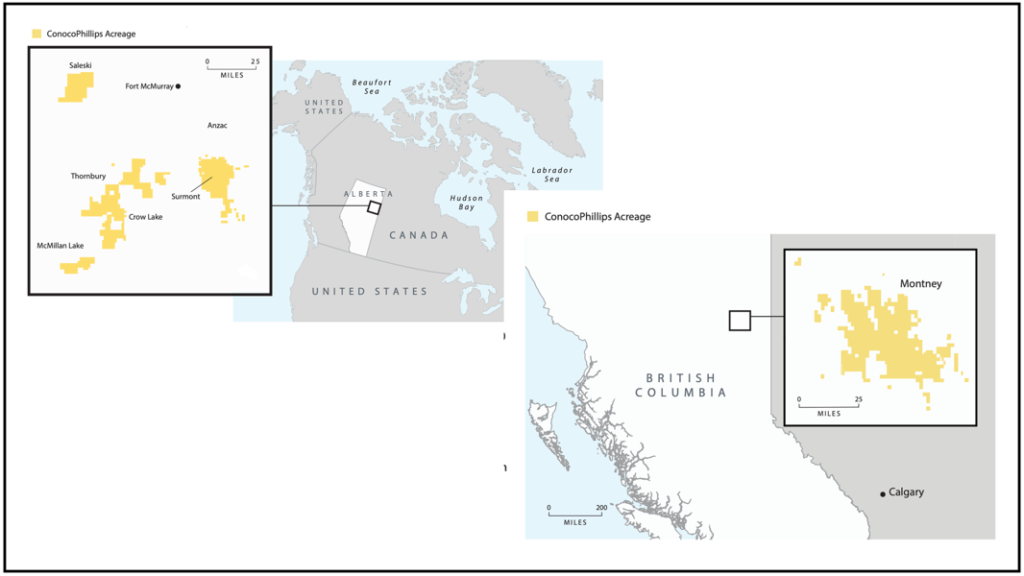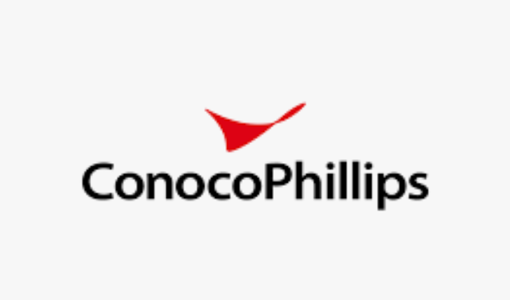Lower 48
The Lower 48 represents the largest segment in ConocoPhillips today based on production. The company has high-quality positions in the North American unconventionals, which are low cost of supply assets with significant upside potential.
The company’s large onshore Lower 48 position of 10.1 million net acres prior to the acquisition of Concho Resources Inc., much of it held by production, gives access to scalable, low cost of supply inventory that can generate many years of future development. The Lower 48 segment is comprised of two regions covering the Gulf Coast and Great Plains. Current major focus areas for the Lower 48 include the Eagle Ford, Bakken and Permian Basin.

In early 2020, the company sold its Niobrara assets in Colorado and its Waddell Ranch assets in the Permian Basin. On Jan. 15, 2021, ConocoPhillips completed the transformational acquisition of Concho Resources Inc., an independent oil and gas exploration company with operations across New Mexico and West Texas. The addition of 550,000 net acres through the Concho acquisition complements the company’s position in the Delaware and Midland basins in the Permian, which together with major positions in the Eagle Ford and Bakken trends establish ConocoPhillips as a leader in Lower 48 unconventional development. Further information on the Concho assets, production and reserves will be included in future Fact Sheets.
Data Download Center
ConocoPhillips Wells Drilled in 2023
.ConocoPhillips Active Drilling Rigs March 2024
ConocoPhillips Map of Wells Drilled Since 2022

Gulf Coast
Eagle Ford
The liquids-rich Eagle Ford tight oil trend, located in the Western Gulf Coast Basin of South Texas, represents one of the company’s most prolific unconventional resource developments. ConocoPhillips was one of the first companies into the liquids play, resulting in a low-cost entry into this acreage. In 2009, the company began exploring the development potential of this play and by year-end 2020 held approximately 200,000 net leasehold and mineral acres, primarily in DeWitt, Karnes
and Live Oak counties.
The company has drilled more than 1,500 wells in the field through the years, representing 30 percent of its potential drilling inventory, and built infrastructure capacity with central facilities and pipelines, with an emphasis on liquids value optimization through the operation of three condensate processing facilities.
The current focus is on full-field development, using customized well spacing and stacking patterns adapted through reservoir analysis. Various well configurations are used depending on location and geology to maximize ultimate recovery. The majority of the wells now being drilled are on multi-well pads at 60-or-80-acre horizontal spacing in high-low or three-layer patterns. Such techniques, combined with improved fracturing and better distribution of proppant in well completions, have enabled ConocoPhillips to achieve greater than 20% recovery rates, with further resources targeted. The company is also piloting methods of enhanced recovery with the intent of further extending economically recoverable resource.
During 2020, there were 71 operated wells brought on line, bringing total wells on line at year-end to more than 1,400. Net production in 2020 averaged 186 MBOED, with approximately 80% of production from liquids.
Through a disciplined focus on technology and innovation, the company has driven efficiency improvements and lowered capital and operating costs. Enhanced flexibility and short-cycle returns on investment allow optionality in the pace of developing the more than 3,600 low cost of supply drilling locations remaining. Additionally, the company plans to refracture 375 existing well locations, enabling increases in the estimated ultimate recoveries. Since field inception, the company has produced more than 500 million BOE here. ConocoPhillips continues building the Eagle Ford into a legacy asset that is expected to yield substantial production for years to come.
Gulf of Mexico
Ursa/Princess
Mississippi Canyon 765, 766, 808, 809, 810,
853, 854
Operator: Shell (45.6%)
Co-venturers: BP (22.6%),
ConocoPhillips (15.9%),
ExxonMobil (15.9%)
The Ursa Field began production in 1999. The Ursa Tension-Leg Platform (TLP), in a water depth of 3,900 feet, is an established infrastructure hub. Ursa began processing third-party production from the Crosby satellite field in 2001, and primary field development on Ursa was completed in 2004. The Princess development is a northern subsalt extension of the Ursa Field. Princess was discovered in 2000, and first production was achieved in 2002 via an extended-reach well from the Ursa TLP. A three-well subsea tieback to the Ursa TLP was completed in 2005 and six additional subsea wells have been tied back since then, including two water-injector wells. In 2020, net production from Ursa and Princess was 7 MBOED.
K2
Green Canyon 518, 561, 562, 606
Operator: Occidental (41.8%)
Co-venturers: Ecopetrol (20.8%), Eni (13.4%),
ConocoPhillips (12.4%), Nippon (11.6%)
The K2 accumulation was discovered in 1999. It was sanctioned for development in 2004 and included a four-well subsea tieback to Marco Polo (Anadarko, GC 608). First production began in 2005, and since then seven additional subsea wells have been tied back to Marco Polo. In 2020, net production was 2 MBOED.
Other
Other non-operated producing properties are located in South Louisiana and the Gulf of Mexico. In 2020, net production from these assets was 4 MBOED.
Coastal Wetlands
ConocoPhillips, through its subsidiary, The Louisiana Land and Exploration Company LLC, is one of the largest private wetlands owners in the United States. Located in southeast Louisiana, the company’s wetlands properties cover approximately 0.6 million acres and are known as the ConocoPhillips Coastal Wetlands.
The Wetlands represent an economic resource for the company through non-operated oil and natural gas activities and land leases, such as for hunting, trapping, fishing and camping. The company also supports and participates in company-sponsored and third-party stewardship initiatives, including coastal restoration and university research.
Great Plains
Bakken
The Bakken trend is a sequence of liquidsrich sand and shale layers in the Williston Basin, which stretches across portions of eastern Montana, western North Dakota and Canada. The company’s position in the Bakken development area is comprised of approximately 610,000 net acres, which include 426,000 net mineral acres and 184,000 net leasehold acres. The company focuses on unconventional tight-oil play development and production in the most prolific portion of the basin.
During 2020, net production averaged 78 MBOED. There were 29 operated wells brought on line during 2020, bringing the total to more than 840 operated wells on line at year-end. Increased recovery per well, optimized completions and reduced well costs, combined with a vast and stable acreage position, provide capital flexibility and strong returns.
The company continues improving operational and capital efficiencies using multiwell pad drilling, completion optimization, facility design changes and data analytics, particularly multi-variate analytics on industry well data. This helped identify optimal well completion designs in the primary producing zones, the Middle Bakken and Three Forks formations. Key factors were tighter fracture cluster spacing, lower proppant and lower proppant-to-fluid ratio, which together yielded cost savings and productivity improvements. Multiwell pad drilling has also significantly reduced our overall environmental footprint.
The company continues developing and implementing innovative methods and technologies to gain further improvements in development of its approximately 750 identified remaining future operated drilling locations. There is also potential for refracturing approximately 250 existing wells to enhance production and increase resource recovery.
Permian Basin
The Permian Basin in West Texas and Southeastern New Mexico is a prime example of leveraging one of the company’s large legacy positions, using new technology and new ideas to test liquids-rich conventional and unconventional plays. The company holds approximately 750,000 net acres in the Permian Basin, which includes 88,000 unconventional net acres in the Delaware Basin, 58,000 unconventional net acres in the Midland Basin, and an additional 21,000 unconventional net acres in various other plays in the Northwest Shelf. A significant portion of the unconventional acreage position consists of deep rights held by shallow conventional production. In 2020, the company brought 16 operated wells on line. Net production for Permian in 2020 was 85 MBOED, which includes 64 MBOED of unconventional production.
The company’s primary Permian unconventional assets in the Delaware Basin offer significant opportunity for growth. The Basin contains stacked development potential in the Wolfcamp, Bone Spring and Avalon formations, with three primary producing zones and several zones under evaluation. Appraisal drilling results have confirmed the most prolific and lowest cost of supply zones, and an active development program is now focused on these targets. Additional unconventional assets are located in the Midland Basin and southeastern New Mexico, with attractive targets in the Wolfcamp, Spraberry and Yeso formations.
ConocoPhillips is developing these assets at a measured drilling pace while assessing optimal well spacing and stacking in the various producing zones. Additionally, the company is utilizing such technologies as time-lapse geochemistry, distributed acoustic sensing, image logs, microseismic data and pressure monitoring. Ongoing improvements in drilling and completion efficiencies, infrastructure development and water management are supported by offtake agreements to further reduce the cost of supply.
The Permian operations in the Central Basin Platform and the Northwest Shelf are legacy positions, mostly held by production. These assets continue to be appraised for growth opportunities and offer development pace optionality and capital flexibility to supplement the growth of the Permian Unconventional program. The company has an ongoing strategy of well workovers, artificial lift optimization and waterflood management activities to maximize the value of the existing base production.
On Jan. 15, 2021, ConocoPhillips completed the acquisition of Concho Resources Inc., greatly expanding the company’s position in the Permian Basin. The addition of complementary acreage in the Delaware and Midland Basins creates a sizeable Permian presence.
Anadarko Basin
The Anadarko Basin asset is comprised of approximately 283,000 net acres within this prolific area, located in the Texas Panhandle and western Oklahoma areas. Production is primarily from stacked liquids-rich and tight-gas Cleveland, Redfork, Granite Wash, Atoka and Morrow formations. In 2020, net production averaged 13 MBOED.
Wyoming and Unita Basin
The Wind River Basin operations area consists of the Madden Field and Lost Cabin Gas Plant located in the Wind River Deep Unit, which covers approximately 44,000 net acres in Fremont and Natrona counties, Wyoming. Natural gas operations are from multiple horizons ranging in depth from 5,000 feet to 26,000 feet, including the Lower Fort Union, Mesaverde, Lance, Cody and Madison formations. The company also has small interests in non-operated Wind River Basin, Powder River Basin and Green River Basin assets in Wyoming. In 2020, total Wyoming net production averaged 6 MBOED.
The Uinta Basin operations include approximately 33,000 net acres in Carbon and Emery counties, Utah. In 2020, the
company’s net production in the basin averaged 2 MBOED.
Facilities
Gulf Coast
Eagle Ford Condensate Processing Facilities In the Eagle Ford field, ConocoPhillips operates two facilities that process lease
condensate into separate streams of natural gas, natural gas liquids and processed condensate that meet market specifications.
The Helena facility, located in Kenedy, Texas, is 100% owned by ConocoPhillips and has 110 MBOED of condensate processing capacity. The Sugarloaf facility near Pawnee, Texas, is 87.5% owned by ConocoPhillips and has 30
MBOED of condensate processing capacity.
Great Plains
Lost Cabin Gas Plant The Lost Cabin Gas Plant, located in Lysite, Wyoming, is operated and 60% owned by
ConocoPhillips. It has approximately 246 MMCFD of natural gas processing capacity and serves the Madden Field in the Wind
River Basin.
Lost Creek Pipeline
The Lost Creek Pipeline, located in central Wyoming, is operated and 65% owned by ConocoPhillips. It transports gas from the Lost Cabin Gas Plant and Madden Field in the Wind River Basin to third-party pipelines.
Canada
The ConocoPhillips Canadian operations are comprised primarily of oil sands assets in the Athabasca region of northeastern Alberta and unconventional development in British Columbia.
Current investment programs are focused on the operated Surmont oil sands development and the liquids-rich Montney unconventional play in northeastern British Columbia. Surmont is a steam-assisted gravity drainage (SAGD) development that contains over a billion barrels of captured resources. There is also further resource upsidefrom the company’s other Canadian oil sands assets.
At Montney, ConocoPhillips has established a major position in a liquids-rich unconventional development play. During 2021, he company started construction on the second phase of our processing facility and progressed its exploration and appraisal activities
ConocoPhillips Canadian Permit Download
Wells Drilled in Canada Since 2021

Oil Sands
Operator: ConocoPhillips (50.0%) Co-venturer: TotalEnergies SE (50.0%) Surmont is located in the Athabasca region of northeastern Alberta, approximately 35 miles south of Fort McMurray. Surmont began in 1997 as a pilot project with the construction of a small SAGD facility located near the company’s current operations. Commercial production from Surmont-1 began in 2007. In 2010, ConocoPhillips commenced construction of Surmont-2, and achieved first production in 2015.
In 2021, net production was 69 MBOED. ConocoPhillips is focused on structurally lowering costs, reducing greenhouse gas emissions intensity, optimizing asset performance and commercial strategy. In 2021, ConocoPhillips signed a long-term commercial contract to process Surmont’s blended bitumen at a Diluent Recovery Unit (DRU) constructed in Alberta, unlocking additional value for the asset. The DRU extracts diluent from the bitumen in Canada, making it readily available for re utilization and sale to the market; allowing DRU product to move by rail as a non-hazardous good with a lower GHG footprint than comparative pipeline transport. By utilizing custom diluents in the US Gulf Coast, ConocoPhillips creates higher value bespoke blends to provide to our refining customers. Additionally, there is opportunity for future capacity expansion. Over the life of this multi-decade project, Surmont will provide many social and economic benefits to the area. In November 2021, ConocoPhillips Canada joined the Oil Sands Pathways to Net Zero alliance, which has a goal to achieve net zero GHG emissions from oil sands operations by 2050 to help Canada meet its climate goals, including the country’s Paris Agreement commitments and 2050 net zero aspirations. The alliance will develop an actionable approach to address emissions, while also preserving the oil sands more than $3 trillion in estimated contribution to Canada’s gross domestic product (GDP) over the next 30 years.
Thornbury, Crow Lake, McMillan Lake and Saleski Operator: ConocoPhillips (100.0%) ConocoPhillips holds other lands in the Athabasca region that contain substantial bitumen resources. These are assets upon which technology improvements can contribute significant economic and environmental benefits to the large resource base and add value to the company’s portfolio.
Unconventional Development
Montney
The Montney is an unconventional resource play located in northeastern British Columbia. At year-end 2021, ConocoPhillips held approximately 300,000 acres of land with 100% working interest within the liquids-rich sweet spot of the Montney.
Exploration and appraisal activities in the area began in 2009. Activity in 2021included drilling three horizontal wells, completing three wells and bringing12 wells onstream. In addition, construction on the second phase of the company’s processing facility was started. Production from the play was 25 MBOED net in 2021. Appraisal drilling and completions activity will continue in 2022. Future development is currently in the planning phase.
ConocoPhillips News


